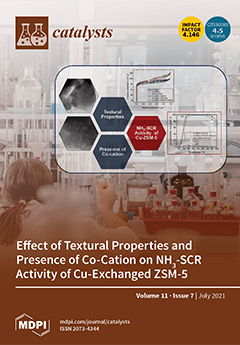In this study, perovskite ZnTiO
3 photocatalysts were fabricated by the sol–gel method. The photocatalytic capability was verified by the degradation of the emerging contaminant, the antibiotic amoxicillin (AMX). For the preparation, the parameters of the calcination temperature and the additional amount of
[...] Read more.
In this study, perovskite ZnTiO
3 photocatalysts were fabricated by the sol–gel method. The photocatalytic capability was verified by the degradation of the emerging contaminant, the antibiotic amoxicillin (AMX). For the preparation, the parameters of the calcination temperature and the additional amount of polyvinylpyrrolidone (PVP) and ammonia are discussed, including the calcining temperature (500, 600, 700, 800 °C), the volume of ammonia (750, 1500, 3000 μL), and the weight of PVP (3 g and 5 g). The prepared perovskite ZnTiO
3 was characterized by XRD, FESEM, BET, and UV-Vis. It is shown that the perovskite ZnTiO
3 photocatalysts are structurally rod-like and ultraviolet light-responsive. Consequently, the synthesis conditions for fabricating the perovskite ZnTiO
3 photocatalysts with the highest photocatalytic performance were a calcining temperature of 700 °C, an additional ammonia amount of 1500 μL, and added PVP of 5 g. Moreover, the photocatalytic degradation of perovskite ZnTiO
3 photocatalysts on other pollutants, including the antibiotic tetracycline (TC), methyl orange (MO), and methylene blue (MB) dyes, was also examined. This provides the basis for the application of perovskite ZnTiO
3 as a photocatalyst to decompose emerging contaminants and organic pollutants in wastewater treatment.
Full article





